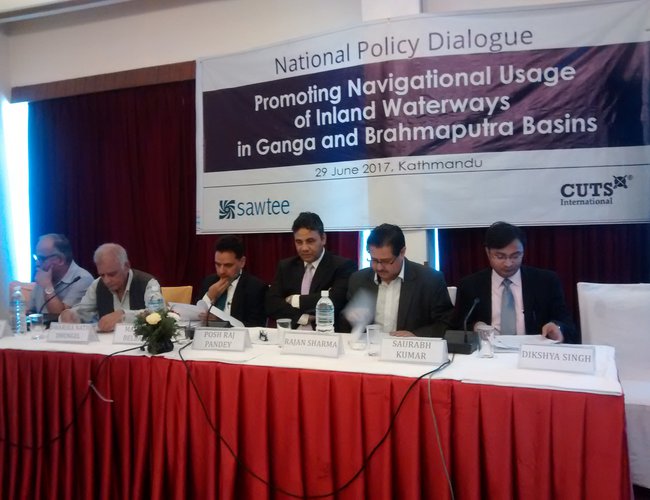
Water resources experts said that there is immense possibility in promoting inland waterways in Ganga and Brahmaputra basins for broader connectivity among the nations of the region including Bhutan, Bangladesh, Nepal and India.
Addressing half day program on expanding tradable benefits of trans-boundary water: promoting navigational usage of inland waterways in Ganga and Brahmaputra basins, renowned water resources experts argued that transboundary waterways can connect the reason to benefits all.
Implemented in partnership with CUTS International (India); Unnayan Shamannay (Bangladesh) and Royal Society for Protection of Nature (Bhutan), the program is to help in recommending a suitable policy discourse for developing inland waterways in Nepal that grants maximum benefits to the local livelihood with a macro objective of improving connecting between countries in eastern South Asia.
Participated by the government officials and other stake holders representing various other organizations, Dikshya Singh, research officer, South Asia Watch on Trade, Economics and Environment (SAWTEE) presented paper on institutional analysis of inland water transport in Nepal: Prospects and challenges.
“Nepal could get access to Haldia Port through the Ganges. As the river navigation is much cheaper than other mode of transport, the government undertakes comprehensive feasibility study of the rivers to assess navigability,” said Singh. He suggested identifying sites for possibility of upgrading existing traditional boats, keeping in mind its social and ecological impact,” suggested Singh.
Presenting study report on expanding tradable benefits of trans-boundary water, Dr. Saurabh Kumar of Consumer Unity and Trust Society (CUTS) said that river Ganga and Brahmaputra river basins have immense possibility to enhance the trade and increase the connectivity. “For the connectivity between Nepal, Bhutan, Bangladesh and India, there is no better way than water ways. We can make the rivers usable for navigation. As India is in the process of development of inland navigation, Bhutan, Bangladesh and Nepal can make a benefit out of this.
Chaired by Dr. Posh Raj Pandey, Ajaya Dixit, Executive Director of ISET-Nepal, Dr. Dwarikanath Dhungel, former water resources secretary, Madhav Belbase, joint secretary, water and energy commission secretariat and Rajan Sharma, former president of Nepal Freight and Forwarders Association presented their views.
Dr. Dhrubesh Chandra Regmi, program director SAWTEE, highlights the importance of National Policy Dialogue.
For a landlocked country, developing inland water transport (IWT) is prescribed as the best possible way to gain access to sea. Nepal, which has more than 6000 rivers with cumulative length of 45,000 km, could be in a place to use the river systems to be connected to international waters.
Unfortunately, navigation in Nepal is limited to country boats used in few stretches of the rivers to enable river crossings. Lack of institutional and physical infrastructure regarding water transport has left inland navigation untapped sector in Nepal. Along with opening up a new economic avenue, having well-equipped inland waterways could be invaluable for swifter and easier trade for Nepal.
Moreover, it could provide impetus to seamless regional connectivity — especially in the eastern region of South Asia, which is recognized as a sub-region on its own Bangladesh-Bhutan India-Nepal (BBIN). Unlike landlocked Nepal and Bhutan, Bangladesh and India have a functional inland water transport system.
Nepal could possibly reap the benefits by getting linked through water with these countries through Ganges River Basin (GRB). South Asia Watch on Trade, Economics and Environment (SAWTEE) is undertaking diagnostic study to assess the situation of water transport system in Nepal under Expanding Tradable Benefits of Trans-boundary Water: Promoting Navigational Usage of Inland Waterways in Ganga and Brahmaputra Basins (IW) Project.
The study includes institutional analysis on the management of policies, laws and regulations with respect to the management of inland waterways in Nepal. The project aims to contribute to improving institutions (i.e. policies, laws, and regulations) for the governance of inland waterways in the BBIN region from the point of view of transport connectivity and livelihood of those directly connected to targeted waterways.
“The objective of this National Policy Dialogue meeting is to share findings gathered from a literature review and diagnostic field survey conducted at locations in the Koshi and Gandak River basins in Nepal. The report has incorporated the comments and suggestions presented by the stakeholders and experts during series of meetings and consultations held in last quarter,” said Dr. Regmi.
- TANAHU HYDROPOWER PROEJCT: A Significant Achievement
- Apr 15, 2024
- AMBASSADOR HANAN GODAR: Sharing Pain With A Nepali Family
- Mar 30, 2024
- VISIT OF KfW AND EIB TO NEPAL : Mission Matters
- Mar 25, 2024
- NEPAL BRITAIN SOCIETY: Pratima Pande's Leadership
- Mar 24, 2024
- NEPAL ARMY DAY: Time To Recall Glory
- Mar 15, 2024
















